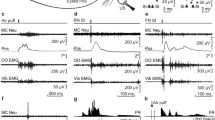Abstract
The availability of transgenic mice that mimic human neurodegenerative processes has made it necessary to develop new recording and stimulating techniques capable of being applied in this species. We have studied here the motor learning and memory capabilities of wild-type and transgenic mice with deficits in cognitive functions, using classical conditioning procedures. We have developed an electrical shock/SHOCK paradigm corresponding to atrace classical conditioning; that is, a learning task involving the cerebral cortex, including the hippocampus. The conditioning procedure is a modification of the air-puff/AIR-PUFF conditioning (Gruartet al., J. Neurophysiol. 74:226, 1995). Animals were implanted with stimulating electrodes in the supraorbitary branch of the trigeminal nerve and with recording electrodes in the orbicularis oculi muscle. Computer programs were developed to quantify the appearance and evolution of eyelid conditioned responses. According to the present results, the classical conditioning of eyelid responses appears to be a suitable (associative) learning procedure to study learning capabilities in genetically-modified mice.
Similar content being viewed by others
References
Chen A, IA Muzzio, G Malleret, D Bartsch, M Verbitsky, P Pavlidis, S Vronskaya, MB Grody, I Cepeda, TC Gilliam and (2003) Inducible enhancement of memory storage plasticity in transgenic mice expressing an inhibitor REB-2) and C/EBP proteins.Neuron 39, 655–669.
Chen, J Knox, J Inglis, A Bernard, SJ Martin, A Justice, D Games, SB Freeman and RGM Morris (2000) eficit related to age and -amyloid plaques in a mouse zheimer’s disease.Nature 408, 975–979.
Chan JM and A Gruart (2002) The role of interpositus yelid conditioned responses.Cerebellum 1, 289–308.
A Gruart and JM Delgado-García (1997) Quantal organization of reflex and conditioned eyelid responses.J. Neurophysiol. 78, 2518–2530.
Gruart A, P Blázquez and JM Delgado-García (1995) Kinematics of unconditioned and conditioned eyelid movements in the alert cat.J. Neurophysiol. 74, 226–248
Gruart A, G Guillazo-Blanch, R Fernández-Mas, L Jiménez-Díaz and JM Delgado-García (2000a) The cerebellar posterior inter-positus nucleus as a reinforcer of classically conditioned eyelid responses in alert cats.J. Neurophysiol. 84, 2680–2690.
Gruart A, S Morcuende, S Martínez and JM Delgado-García (2000b) Involvement of cerebral cortical structures in the classical conditioning of eyelid responses in rabbits.Neuroscience 100, 719–730.
Gruart A, BG Screurs, E Domínguez del Toro and JM Delgado-García (2000c) Kinetic and frequency-domain properties of reflex and conditioned eyelid responses in the rabbit.J. Neurophysiol. 83, 836–852.
Kugelberg E (1952) Facial reflexes.Brain 75, 385–396.
Marshall-Goodell B, EJ Kehoe and I Gormezano (1992) I. Laws of the unconditioned reflex and rabbit nictitating membrane preparation.Psychobiology 20, 229–237.
Moechars D, I Dewachter, K Lorent, D Reversé, V Baekeladt, A Naidu, I Tesseur, K Spittaels, C Van Dern Haute, F Checler, E Godaux, B Cordell and F Van Leuven (1999) Early phenotypic changes in transgenic mice that overexpress different mutants of amyloid precursor protein in brain.J. Biol. Chem. 274, 6483–6492.
Múnera A, A Gruart, MD Muñoz and JM Delgado-García (2000) Scopolamine impairs information processing in the hippocampus and performance of a learned eyeblink response.Neurosci. Lett. 292, 33–36.
Munera A, A Gruart, MD Muñoz, R Fernández-Mas and JM Delgado-García (2001) Hippocampal pyramidal cells activity encodes conditioned stimulus predictive value during classical conditioning in alert cats.J. Neurophysiol. 86, 2571–2582.
Selkoe DJ (2002) Alzheimer’s disease is a synaptic failure.Science 298, 789–791.
Terry Jr AV and JJ Buccafusco (2003) The cholinergic hypothesis of age and Alzheimer’s disease-related cognitive deficits: recent challenges and their implications for novel drug development.J. Pharmacol. Exp. Ther. 306, 821–827.
Trinh NH, J Hoblyn, S Mohanty and K Yaffe (2003) Efficacy of cholinesterase inhibitors in the treatment of neuropsychiatric symptoms and functional impairment in Alzheimer disease: a meta-analysis.JAMA 289, 210–216.
Trigo JA, A Gruart and JM Delgado-García (1999) Discharge profiles of abducens, accessory abducens and facial motoneurons during reflex and conditioned eyelid responses in alert cats.J. Neurophysiol. 81, 1666–1684.
Vogel RW, M Ewers, C Ross, TJ Gould and DS Woodruff-Pak (2002) Age-related impairment in the 250-millisecond delay eye-blink classical conditioning procedure in C57BL/6 mice.Learn. Mem. 9, 321–336.
Woodruff-Pak DS, RG Finkbiner and DK Sasse (1990) Eyeblink conditioning discriminates Alzheimer’s patients from non-demented aged.Neuroreport 1, 45–48.
Author information
Authors and Affiliations
Corresponding author
Rights and permissions
About this article
Cite this article
Rodríguez-Moreno, A., Toro, E.D.D., Porras-García, E. et al. The use of alert behaving mice in the study of learning and memory processes. neurotox res 6, 225–232 (2004). https://doi.org/10.1007/BF03033224
Received:
Revised:
Issue Date:
DOI: https://doi.org/10.1007/BF03033224




